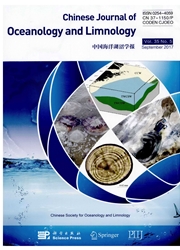

 中文摘要:
中文摘要:
为了为中国在里面轨道和安排海洋获得高质量的运作的数据产品,渲染传感器,二运作的大气的修正(交流) 的表演算法(ESA MEGS 7.4.1 和 NASA SeaDAS 6.1 ) 用 MERIS 数据在华东海(ECS ) 上被评估。光谱遥感反射 R rs (), 喷雾器光厚度(AOT ) ,并且 ? ngstr ? m 代表() 使用二个算法检索被验证在在 2002 年 5 月和 2009 年 10 月之间获得的 situ 大小使用。R rs , AOT,并且在之间在里面 situ 和 MERIS 数据通过严格的排除标准被获得。R rs () 在 490-560 nm 显示出 9%-13% 的吝啬的百分比差别(MPD ) 光谱范围,和重要 overestimation 在 413 nm 被观察(MPD >72%) 。AOT 被过高估计(MPD >32%) ,并且尽管 ESA 算法在蓝绿色的乐队超过了 NASA 算法,状况在 red-near-infrared 乐队被颠倒。价值被 ESA 算法(MPD=41%) 然而并非由 NASA 算法(MPD=35%) 显然低估。澄清 NASA 算法为什么在检索更好表现了,散布单个散布反照率(SSA ) 的阴谋密度被准备。这些 -SSA 密度散布显示出的阴谋喷雾器模型的适用性在 ECS 上由 NASA 算法使用了,这比由 ESA 算法使用了的好,尽管任何一个喷雾器模型都不对 ECS 区域合适。这研究的结果在 ECS 上关于运作的数据产品和调查的使用提供引用给数据用户和数据机构进当前的交流计划的改进。
 英文摘要:
英文摘要:
To acquire high-quality operational data products for Chinese in-orbit and scheduled ocean color sensors, the performances of two operational atmospheric correction(AC) algorithms(ESA MEGS 7.4.1 and NASA Sea DAS 6.1) were evaluated over the East China Seas(ECS) using MERIS data. The spectral remote sensing reflectance R_(rs)(λ), aerosol optical thickness(AOT), and ?ngstr?m exponent(α) retrieved using the two algorithms were validated using in situ measurements obtained between May 2002 and October 2009. Match-ups of R_(rs), AOT, and α between the in situ and MERIS data were obtained through strict exclusion criteria. Statistical analysis of R_(rs)(λ) showed a mean percentage difference(MPD) of 9%–13% in the 490–560 nm spectral range, and significant overestimation was observed at 413 nm(MPD〉72%). The AOTs were overestimated(MPD〉32%), and although the ESA algorithm outperformed the NASA algorithm in the blue-green bands, the situation was reversed in the red-near-infrared bands. The value of α was obviously underestimated by the ESA algorithm(MPD=41%) but not by the NASA algorithm(MPD=35%). To clarify why the NASA algorithm performed better in the retrieval of α, scatter plots of the α single scattering albedo(SSA) density were prepared. These α-SSA density scatter plots showed that the applicability of the aerosol models used by the NASA algorithm over the ECS is better than that used by the ESA algorithm, although neither aerosol model is suitable for the ECS region. The results of this study provide a reference to both data users and data agencies regarding the use of operational data products and the investigation into the improvement of current AC schemes over the ECS.
 同期刊论文项目
同期刊论文项目
 同项目期刊论文
同项目期刊论文
 Double SST fronts observed from MODIS data in the East China Sea off the Zhejiang–Fujian coast, Chin
Double SST fronts observed from MODIS data in the East China Sea off the Zhejiang–Fujian coast, Chin Overview of Chinese spaceborne ocean observing systems, onboard sensors and data products (1988-2025
Overview of Chinese spaceborne ocean observing systems, onboard sensors and data products (1988-2025 Influence of atmospheric and sea-surface corrections on retrieval of bottom depth and reflectance us
Influence of atmospheric and sea-surface corrections on retrieval of bottom depth and reflectance us Improvement of the ADEOS-II/GLI sun-glint algorithm using concomitant microwave scatterometer-derive
Improvement of the ADEOS-II/GLI sun-glint algorithm using concomitant microwave scatterometer-derive An empirical algorithm for determining the diffuse attenuation coefficient Kd in clear and turbid wa
An empirical algorithm for determining the diffuse attenuation coefficient Kd in clear and turbid wa Water and bottom properties of a coastal environment derived from Hyperion data measured from the EO
Water and bottom properties of a coastal environment derived from Hyperion data measured from the EO 期刊信息
期刊信息
